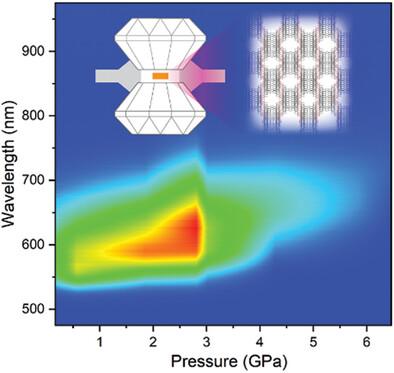Pressure-Modulated Luminescence Enhancement and Quenching in a Hydrogen-Bonded Organic Framework
IF 13
2区 材料科学
Q1 CHEMISTRY, MULTIDISCIPLINARY
引用次数: 0
Abstract
Light emission in the solid state is central for illumination, sensing, and imaging applications. Unlike luminescence in dilute solutions, where the excited states are unimolecular in nature, intermolecular interaction plays a significant role in the quantum yield of solid-state luminophores, manifested as competing aggregation-caused quenching (ACQ) and aggregation-induced enhancement (AIE). Both effects are extensively studied in various systems; however, it remains unclear how their competition depends on molecular conformation and intermolecular stacking. Here the direct observation of pressure-modulated AIE-ACQ competition in a crystalline hydrogen-bonded organic framework (HOF) is reported. Using in situ spectroscopies and computational modeling, the intramolecular vibration and intermolecular π–π stacking directly responsible for the non-radiative decay of the excited state are identified. The extent of these two contributions is modulated by hydrostatic pressure and guest molecules in the HOF pores. This work demonstrates a physically neat model system to understand and control solid-state luminescence, and a potential material platform for piezoluminescent sensing.

求助全文
约1分钟内获得全文
求助全文
来源期刊

Small
工程技术-材料科学:综合
CiteScore
17.70
自引率
3.80%
发文量
1830
审稿时长
2.1 months
期刊介绍:
Small serves as an exceptional platform for both experimental and theoretical studies in fundamental and applied interdisciplinary research at the nano- and microscale. The journal offers a compelling mix of peer-reviewed Research Articles, Reviews, Perspectives, and Comments.
With a remarkable 2022 Journal Impact Factor of 13.3 (Journal Citation Reports from Clarivate Analytics, 2023), Small remains among the top multidisciplinary journals, covering a wide range of topics at the interface of materials science, chemistry, physics, engineering, medicine, and biology.
Small's readership includes biochemists, biologists, biomedical scientists, chemists, engineers, information technologists, materials scientists, physicists, and theoreticians alike.
 求助内容:
求助内容: 应助结果提醒方式:
应助结果提醒方式:


